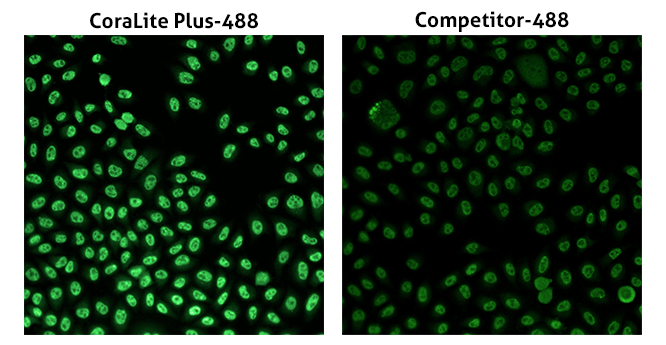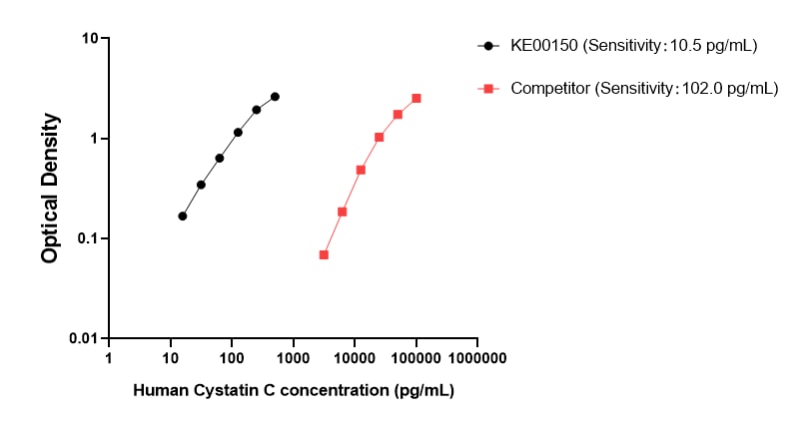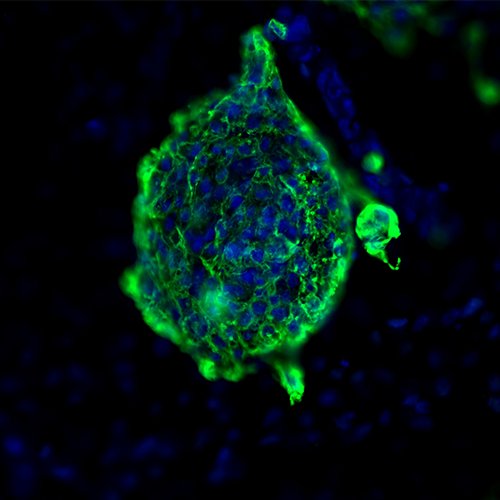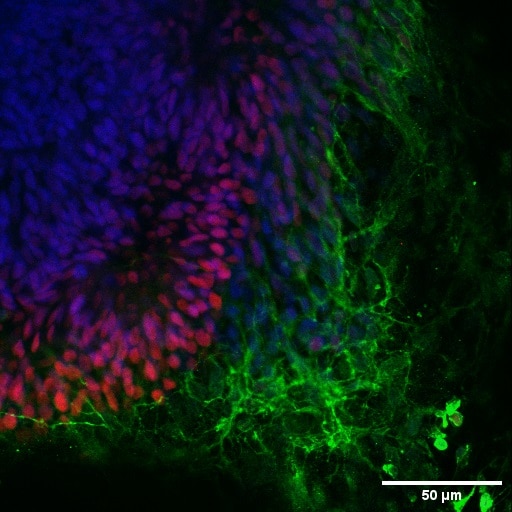Organoid Research Solutions
Organoids are more physiologically relevant models than traditional 2D cultures, transforming the outcomes of basic research, preclinical model development, and clinical applications. Our comprehensive reagent offering of high-quality growth factors, antibodies, ELISA kits, and more is carefully curated to enhance organoid workflow experience.
Validation in organoid models
Well-validated reagents ensure experimental consistency and improve the physiological relevance of organoid-based models in drug discovery and disease modeling.
GMP grade for clinical manufacturing
Comprehensive portfolio of GMP-grade reagents streamlines workflow optimization and accelerates the development of organoid-based therapeutics and personalized medicine.
Organoid workflow optimization support
Expert guidance to fine tune the reagent concentrations, exposure timing, and handling technique to accelerate the path to an optimized workflow development.

Neuronal differentiation of SHSY5Y cells using BDNF and retinoic acid showing higher neuronal differentiation using HumanKine BDNF in comparison to E. coli derived BDNF.
HumanKine
HumanKine is a line of recombinant human growth factors produced in HEK293 human cells, offering native human post-translational modifications and correct protein folding that enhance biological activity, facilitating improved cell differentiation. HumanKine is animal component free (ACF), which eliminates the risk of contamination from animal-derived pathogens and reduces variability caused by undefined serum components, ensuring higher consistency and reproducibility in experiments. It is also the largest selection of GMP grade growth factors, which further supports translating various organoids from research to clinical application.
Antibodies
Proteintech offers a comprehensive portfolio of conjugated antibodies, including the industry-leading CoraLite® and CoraLite® Plus dye series. CoraLite dyes are engineered for superior brightness, photostability, and minimal spectral overlap, making them ideal for high-content imaging and multiplex imaging of complex organoids. This expansive offering can streamline organoid characterization and gain deeper insights into disease modeling, drug screening, and regenerative medicine.

Immunofluorescence of a nuclear protein with CoraLite Plus-488 antibody in comparison to a similar product from a leading competitor demonstrating higher signal to background ratio for CoraLite Plus.

Detection of Cystatin C using ELISA kits demonstrates 10X higher sensitivity for AuthentikineELISA in comparison to competitor ELISA.
ELISA Kits
Proteintech ELISA kits offer superior performance by deriving antibodies and standards from the same immunogen, ensuring unmatched accuracy and consistency in quantification. This design minimizes cross-reactivity, which is especially important when analyzing complex samples like the organoid secretome. AuthentiKine kits are validated with recombinant proteins expressed in human cells, making them more biologically relevant and reflective of native protein structure and function. Their high sensitivity and lot-to-lot consistency make them ideal for detecting subtle changes in cytokine and growth factor levels in organoid cultures.
Products for organoid differentiation and characterization
| Organoid Type | Growth Factor | Characterization Marker |
|---|---|---|
| Cerebral Organoids | EGF | PAX6 |
| FGF2 | SOX2 | |
| BDNF | TBR1 | |
| NT3 | TUJ1 | |
| MAP2 | ||
| GFAP | ||
| Retinal Organoids | IGF-1 | PAX6 |
| DKK1 | CRX | |
| Noggin | NRL | |
| FGF2 | VSX2 | |
| Recoverin | ||
| Lung Organoids | Wnt3a | NKX2.1 |
| EGF | SOX2 | |
| Noggin | SOX9 | |
| FGF10 | SFTPC | |
| BMP4 | FOXJ1 | |
| KGF (FGF7) | ||
| Intestinal Organoids | EGF | CDX2 |
| Noggin | LGR5 | |
| R-spondin1 | MUC2 | |
| Wnt3a | Villin | |
| Lysozyme | ||
| Chromogranin A | ||
| Gastric Organoids | EGF | SOX2 |
| FGF10 | PDX1 | |
| Noggin | MUC5AC | |
| Wnt3a | GATA4 | |
| Liver Organoids | HGF | AFP |
| EGF | ALB | |
| FGF10 | HNF4α | |
| Oncostatin M | CK18 | |
| Wnt3a | CYP3A4 | |
| Pancreatic Organoids | EGF | PDX1 |
| Noggin | NKX6.1 | |
| R-spondin1 | INS | |
| Wnt3a | GCG | |
| Betacellulin | ||
| KGF (FGF7) | ||
| FGF10 | ||
| Kidney Organoids | Activin A | WT1 |
| GDNF | PAX2 | |
| FGF9 | E-Cadherin | |
| NPHS1 | ||
| Cardiac Organoids | FGF2 | cTnI |
| BMP4 | NKX2.5 | |
| Activin A | cTnT | |
| VEGF | MYL2 | |
| ACTN2 | ||
| Thymic Organoids | BMP4 | FOXN1 |
| KGF (FGF7) | KRT5 | |
| FGF10 | KRT8 | |
| AIRE | ||
| DLL4 | ||
| Esophageal Organoid | Wnt3a | P63 |
| R-spondin1 | SOX2 | |
| Noggin | KRT5 | |
| FGF10 | KRT13 | |
| NKX2.1 | ||
| Prostate Organoid | Wnt3a | AR |
| R-spondin1 | NKX3.1 | |
| Noggin | KRT8 | |
| FGF10 | KRT5 | |
| EGF | PSA | |
Validation Data Gallery

Cardiomyocyte derived from iPSCs characterized using Cardiac Troponin T Antibody and Nuclear stain DAPI (blue).

Retinal organoids generated from human iPSCs stained for Tubulin beta 3/TUJ1 (green), PAX6 (red), and Nuclear stain DAPI (blue). Credits: Alessandro Bellapianta at Johannes Kepler Universitat, Austria.

Human iPSC-derived microglia (white) residing within an in vivo brain-like organoid environment (blue) derived using HumanKine TGF beta 1, BMP-4, and TPO. Credits: Simon T. Schafer & Monique Pena, Technical University of Munich, Center for Organoid Systems.
